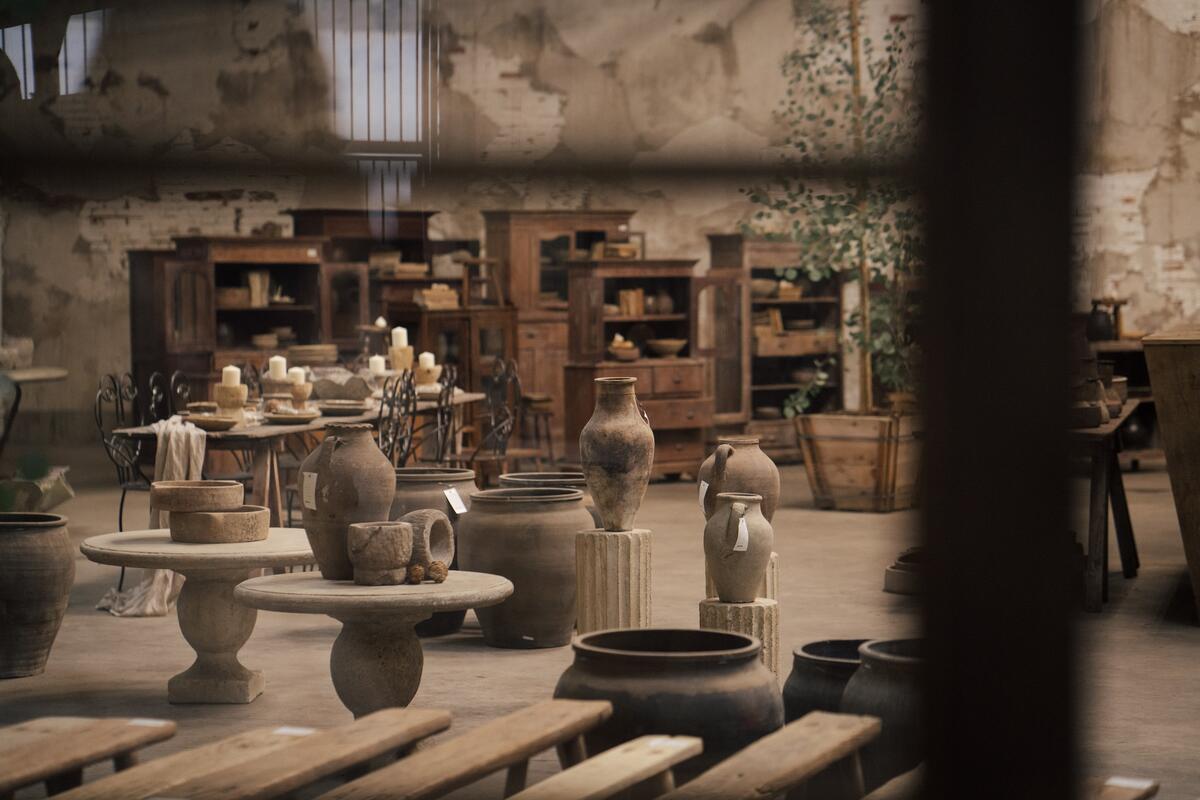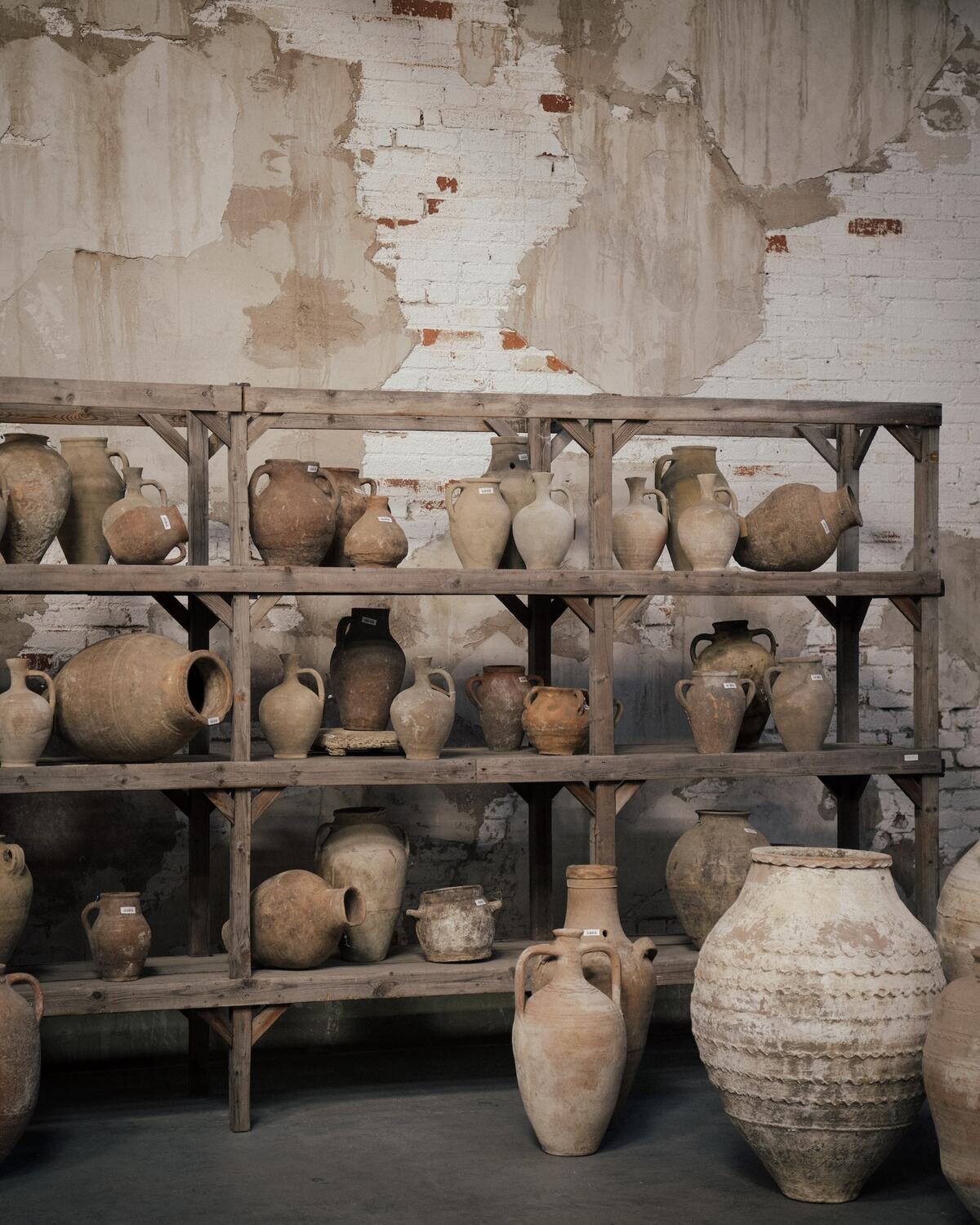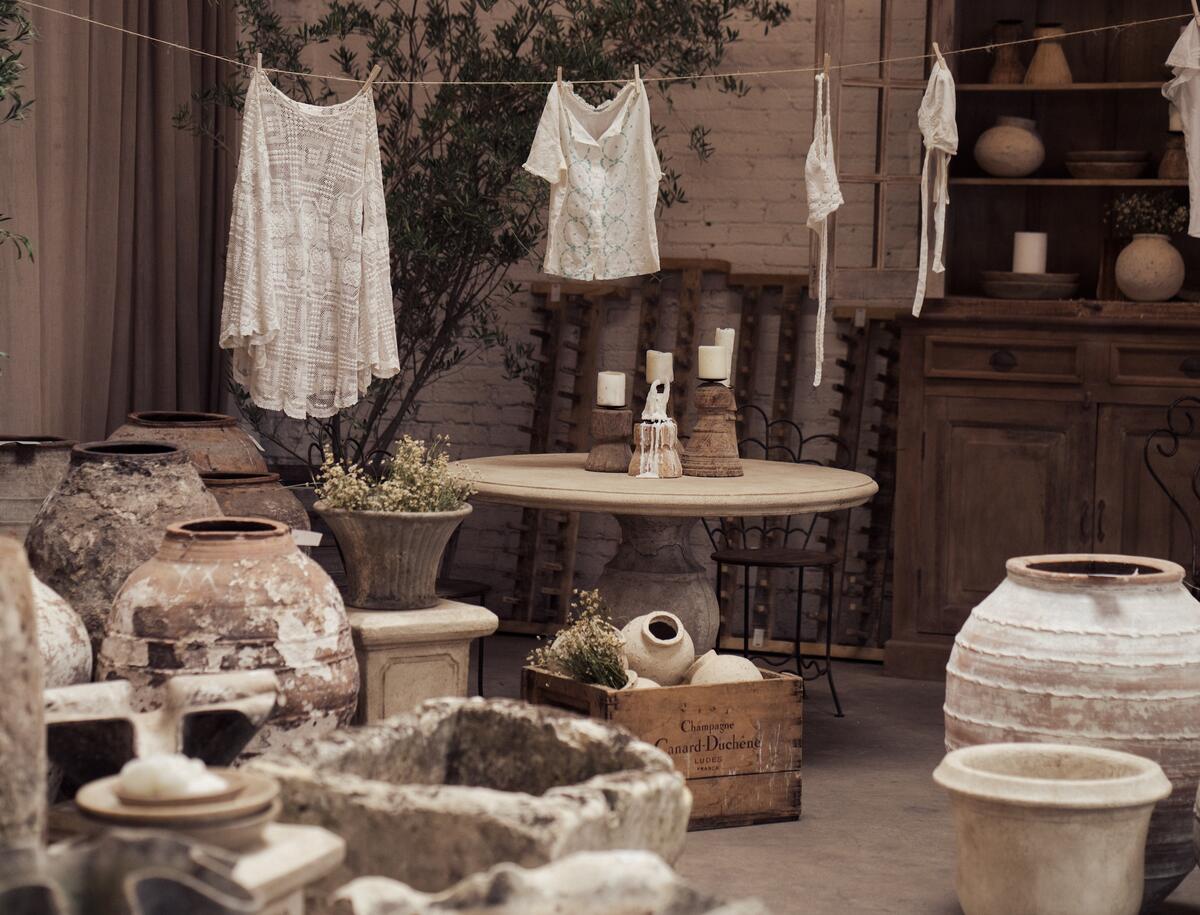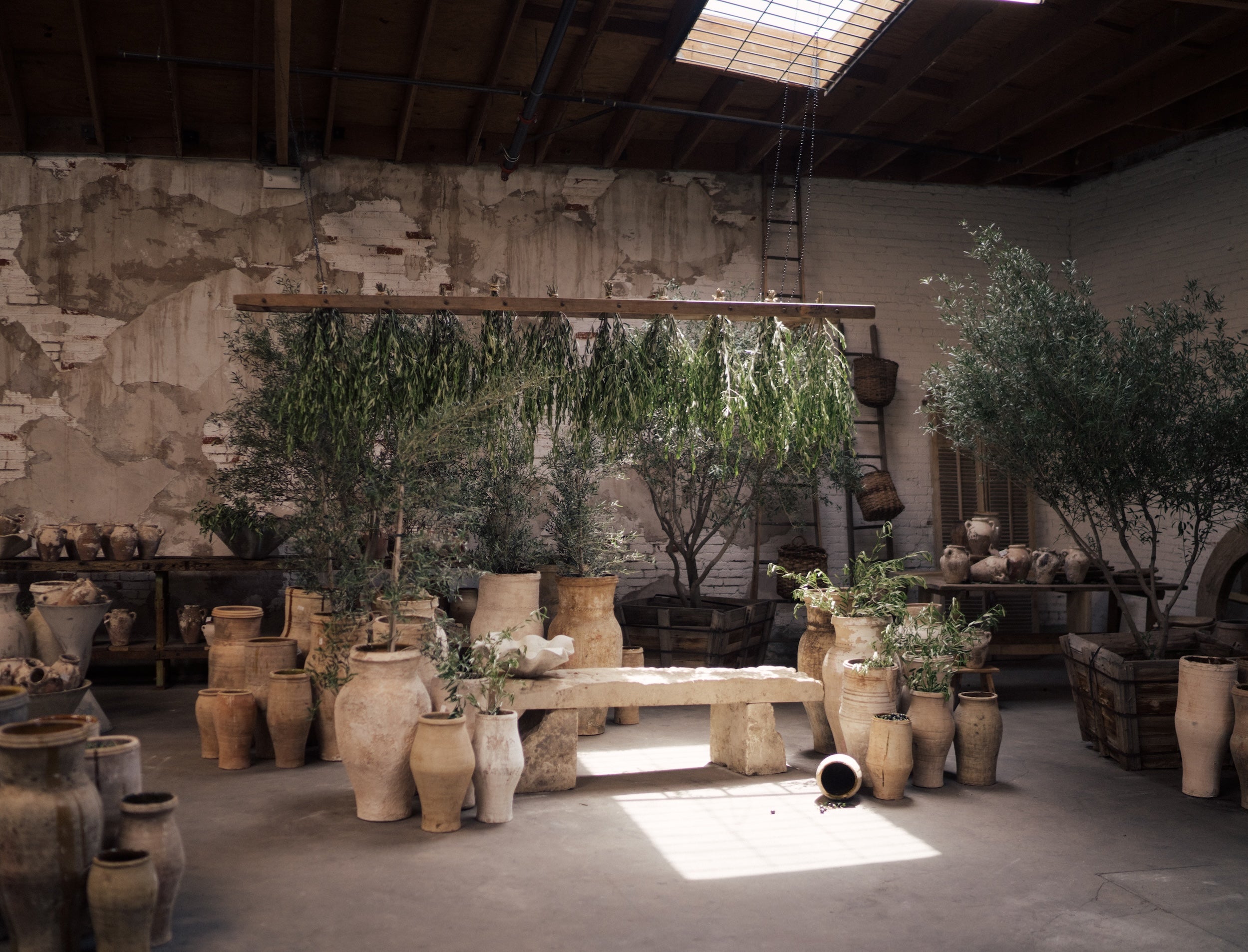In Business of Home’s series Shop Talk, we chat with owners of home furnishings stores across the country to hear about their hard-won lessons and challenges, big and small. This week, we spoke with Kendall Knox of the Los Angeles–based retailer, importer and lifestyle brand Olive Ateliers.
In June 2021, Knox and her two co-founders—her now-husband Ben Knox and friend Laura Sotelo—began curating drops of vintage products that they sourced overseas and publicized on social media. It was a passion project arranged around arrivals of containers and their full-time jobs, but the business (helped along by some celebrity customers who would post about their purchases) was an immediate success. The trio soon opened a soaring 60,000-square-foot space in the downtown L.A. arts district, filling it with stone vessels, ancient-looking breadboards and benches, and fluttering olive trees. The clamor for their “objects with old souls” from folks like Jennifer Lopez, Kim Kardashian, Brigette Romanek and Jeremiah Brent has pushed the business to get bigger and bigger. As Knox explains ahead, “Trusting that the customer has our best interest at heart is one way that we’re building carefully.”

What was your career like before Olive Ateliers?
I come from the brand marketing side of the fashion industry—PR, talent and influencer relations. Prior to Olive [Ateliers], I was at Revolve and Fwrd, and helped [transition their parent organization] into a public company, so I’m well-versed in building a lifestyle brand. I have also worked at B Corps: I worked for Thrive Market, leading the brand marketing function there. Ben, [meanwhile], comes from a very entrepreneurial background. He started a packaged consumer brand, which he sold a few years ago. He has also worked at Red Bull and Super Coffee, so he has great experience building brands and selling businesses. Our third business partner, Laura, studied interior design and comes from estate management. The three of us have unique skill sets that really work well together. I think we share this innate love for the objects that we source and sell. That combination made Olive what it is today.
Tell me about the genesis of Olive.
Olive was a side hustle, I’ll be real. We were working full-time jobs and were reflecting on what we love and what fills our cup. We enjoyed the businesses we were working for, but building something was what was missing for us. The three of us have an innate love for what we call “objects with old souls.” We struggled to find those objects, and when we did, they were across the world and you had to ship through Etsy or whatever at crazy prices. Or maybe it was just a crazy-high retail price because it was in a tiny boutique and there was only one [source] to choose from.
So we set out to fill a gap in the market, and to create a destination where beautiful and unique objects could live in abundance and at fair prices. What we consider to be a fair price is basically a price that abandons the inflated markup that a lot of retailers opt for—and rightfully so, depending on the business model! We were lucky enough to be able to do things a little differently. It started with the drop model, [which made sense] because we did have full-time jobs. We could only open doors every two weeks to welcome customers. The nature of what we source is that it comes [to the U.S. via] containers. It’s inconsistent as to when you’ll receive the goods and be able to open up shop. It was a little bit strategy, but also a little bit the true nature of the business—you open up when you can and you sell when you can, and then you close up when you can’t.
Was there a brick-and-mortar component from the beginning, or were you thinking it would be a warehouse and e-comm?
When we started, we were dropping tiny collections of 10 or 20 items on Instagram out of our backyards. Very quickly, there was a demand from the community for an in-person experience, so we did a pop-up out of a small warehouse in Venice Beach. We didn’t really know how it would translate; people loved the content we were creating and the objects that we were selling via Instagram, but would it [work] in person?
When we arrived the first day, there was a line wrapped around the block waiting for us. We were like, “OK, this is going to work—and an in-person experience is critical.” From there, we’ve been scaling that in-person experience carefully, but also as rapidly as we can to meet demand. I think it was May of last year that we started to drop collections online officially. The [physical space] existed, but we would only open doors once a month for four hours with a limited assortment available for the nationwide community to shop. We weren’t fully set up to be open and functioning like we are today.
How were you able to build that major buzz from the beginning?
I think it’s a very unique intersection of beautiful objects that were very hard to find, honestly. That in itself was exciting and liberating for people—to discover that chase, that hunt, coupled with that they were fairly priced so you could actually buy them. It wasn’t like you were going to show up to this warehouse and be like, “Well, I have to leave. I can’t afford anything here.” And then yes, couple that with us creating really beautiful content and showcasing the objects in a lifestyle setting, versus just “Swipe up to shop” or “Here’s something to buy.” That created excitement among influencers and celebrities, because they, too, wanted to come and experience it, create content in the space, share that with their communities, [and] there was no one influencer or celebrity you can attribute it to. I would say it was the combination of the product, the price strategy, and the lifestyle brand that we were creating.

What is the brand and its general aesthetic?
The brand is innately nostalgic. Literally anything that is of age or is inspired by something of age is what we represent. It’s a very lived-in feel. There is texture, there is natural light, there are natural elements, there’s a beautiful olive tree in the center of the space. All of what we source and sell is a natural material, whether that’s wood or stone or onyx. We’re trying to create a very immersive experience. Anytime you enter the space, you’re overwhelmed with options, but in the best way possible. You’re not walking into an everything store that has thousands of things. You’re walking into a space that is very well curated—in abundance. It’s a very curious brand. We want to learn about the objects that we’re sourcing, the history of those objects, and then storytell to our community. We want our community to have a beautiful, curious home where folks enter and say, “That vessel is insane. Where did that come from? Tell me about it.”
Tell me about the sourcing process.
We source from all over the globe—mostly Turkey, France, India, Indonesia, Morocco and China. We approach sourcing thoughtfully and ethically. One of our leadership principles is “Do good.” So it’s not that we’re just taking from somewhere—we’re also trying to give back wherever we can. We’re in constant communication with our sources and our [buying] agents to ensure that we’re both learning about the history of the object and passing that information on, and that we’re giving back to that region. For example, when working with our Turkish vendor, they work with the local museum to make sure that every object being exported is verified as not having historical worth. They make sure that the museum has enough of this object on display and accessible to the local community while also being able to export certain objects.
Another example: In Indonesia, we’ve implemented a program where, when we source these vintage limestone troughs, they come from communities that are using them to store water, to purify water or to feed animals. We’re carving new limestone vessels to replace the vintage ones for them, so that they can continue to use those resources without needing to go and buy a plastic bucket or something that is just not a good thing for the earth and for them.
Honestly, we don’t [often] storytell around this. We like this to be something that just happens in the background, the right thing to do. This is probably the first time we’ve actually shared this information. But another example is that one of the workshops that we work with in Indonesia produces all of our beautiful onyx pieces. We found out through our agent there that they didn’t have working bathroom facilities, so we invested in setting that up for them to make sure that they were safe and sanitary and [workers] could do their job in a happy and healthy way.
How are you finding these vendors? Do you travel there, or have hunters there?
It’s a combination. We do travel to these places—Turkey, France, Indonesia, India, mostly. We go and we source and select ourselves, but we also have a combination of agents in various locations sourcing on our behalf. They’re well-versed in the brand and the types of objects that we’re interested in. We’re still a very small business, and there’s a lot going on here that we need to be present for, but as much as we can, we’re getting to these regions and working with our partners there to better strengthen our relationships.
Who is your typical customer, and how much of it is the trade?
We are very split between the general retail consumer and the trade—we have a network of over 3,000 trade members at this point. This industry has existed for a very long time, but I think folks never really knew where to turn for objects like these. You might go to 1stDibs and find beautiful curated pieces, but at pretty expensive prices. Or you might turn to Pottery Barn and choose a dupe because it meets your needs. We’re trying to fill that gap for the everyday consumer, but working very robustly with the trade through a portal [on our website] that allows them to see our full assortment and work with us more frequently.
Can you tell me more about the drops and why you think they work?
The monthly drops that did occur are no longer necessary; you can shop anytime. As containers arrive, we process the inventory and then set up a beautiful immersive look and feel for people to experience. We’ll be continuing to drop as inventory permits, while also bringing in new arrivals every single week, both online and in person, to make sure that there’s always something new.
And you’ve executed a big e-commerce expansion, right?
Yes, we’re currently live with that. We are now shoppable online all the time. There are three ways to shop us: online, in person or via our concierge service, which essentially is personal shopping paired with design guidance, which we offer based out of our L.A. showroom. To build the infrastructure and have the space and the team and the resources and the objects to pull that off was a massive undertaking. It’s funny—we’ve only existed for three years, but we’re so very ambitious that it’s like, “OK, what’s next?” Every time we’ve expanded or broadened access to the objects, we’ve turned to each other and said, “What is the next thing that our customer needs? Let’s start focusing on that.” So it’s a huge milestone for us, but it’s also feeling very much like we’re just getting started.

How do you scale carefully? Especially in recent years, with the pandemic boom, there have been so many home brands that have grown too quickly and flamed out.
We really lead with our customer obsession: Any decision made for the business is around what the customer demands and wants and needs. That is core to our decision process as we scale. To be shoppable Wednesday to Saturday in person was because the customer was demanding that from us. The expansion online is because the customer is demanding that of us. Trusting that the customer has our best interest at heart is one way that we’re building carefully.
We’re always going to have vintage and antique and found objects at the core of the brand, but we are starting to design and produce vintage-inspired objects that are unique and special, and that can be woven into the lifestyle that is Olive Ateliers. That’s something we see as a huge opportunity for the business moving forward.
And you just launched attire, right?
Yeah—a fancy way of saying merch. Similarly, the customer was constantly asking, “Oh, do you have a sweatshirt? Can I have a hat? I want to represent your brand in a way beyond just putting an object in my home.” And so we actually partnered with a really talented artist, Alexis Stiteler, and she hand-sketched some of our beautiful objects and we had them printed onto sweatshirts, locally, in small batches. I think it’s just an extension of the lifestyle brand that we’re building. And again, it was something that the customer wanted, so why not?
I want to go back to the celebrity aspect. What role, if any, has this clientele played in Olive’s success?
We’re really humbled that celebrity clients have paid attention to us and been attracted to the brand. Melissa McCarthy walked into our Venice pop-up back in 2021 and wanted to buy breadboards as gifts for her staff. She posted organically, just saying, “This is a cool small business. I think that these guys are doing something interesting and different.” Kristen Bell came into the Culver City–based [location], which was our first-ever official [store], and just went crazy shopping for her home. She shared one of our Reels, and it created buzz [that caused] 500 people to show up to the next drop and line up around the block waiting to shop. Kim Kardashian reached out, wanting two of our onyx side tables, which were pieces we’d designed ourselves, and then she posted on her Instagram saying we were her favorite home decor store.
It builds brand awareness, and that’s incredible, but it doesn’t necessarily equate to crazy revenue spikes or anything like that. But our community goes well beyond celebrity clientele. There are people all over the country that are just so sweet and cheering us on and maybe haven’t purchased before but really have our backs and reach out all the time, being like: “We love what you’re doing. Keep it up! Can’t wait until you open a store here.” It is a beautiful community.
What are your future hopes for the brand?
We have high hopes of expanding to other markets. It’s on the roadmap. I won’t say when, but it’s inevitable. We have a huge community based on the East Coast, in and around New York. Miami screams at us for a location, so we were planning on doing that this year, but in an effort to not scale too quickly, we said, “Let’s put a pin in it. Let’s focus on online expansion and then let the dust settle and reassess next year.”
We are working on our own collections and our own designs currently in a variety of categories. I mentioned we have this concierge service. Some people like to leverage it for personal shopping from afar. Some people want that true design service. We create a design presentation of their home, and we show them which objects we recommend. It’s not full-scale interior design; it’s more of a styling service. But it does help them bridge the gap between that potentially expensive interior designer and a little bit of guidance in designing their home. So that’s an area that we’re super focused on as well—making sure that we’re better serving the customer and helping them experience the brand however they choose to.
What’s your favorite day in the shop?
Our HQ is based out of the [showroom], so I’m definitely there every day running around with my dogs. There are so many different great days, but when I step out of the office and beeline to the kitchen to see people smiling and interacting with the brand and the objects, it just brings so much joy to me and to my business partners. [Customers] bring their kids, their dogs, their moms. We built this brand because we were passionate about it, and to see that being passed on to other people and seeing the interactions that they have with the brand and with our team—that, for me, is the best day possible.





























